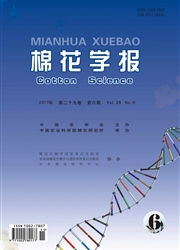

 中文摘要:
中文摘要:
对通过花粉管通道注射获得的转Bt+Sck双价基因抗虫棉纯系312—5T2和332—2T2进行了生物抗虫性测定,转基因纯系对棉铃虫的抗性显著高于非抗虫对照苏棉16和抗虫对照品种sGK321,与抗虫对照R19抗虫性相当。遗传分析表明,转Bt+Sck双价基因抗虫棉的抗性基因符合一对显性基因的分离规律。对转Bt+Sck双价基因抗虫棉与R19及sGK321的杂交F1进行了抗虫性测定,所有的F1植株都表现出与转Bt+Sck基因纯系亲本一致的抗虫性。转Bt+Sck双价基因抗虫棉纯系312—5T2和332—2T2等位性测验证明:312—5T2与R19、sGK321的抗虫基因整合位点不连锁,表现为15:1的自由组合比例;而332-2T2与R19中抗虫基因的整合位点表现连锁,与sGK321的抗虫基因表现自由组合。这为培育新的双价抗虫棉品种(系)提供了优良的育种材料。
 英文摘要:
英文摘要:
At present, scientists are engaged in engineering plants with two or more resistant genes in order to delay and prevent the adaptation in pest species, prolong the usage of life span of transgenic plants and broaden resistant spectrum. Thus, the Bt and Sck(modified CpTI gene)gene, driven by CaMV35S promoter and CLCuV promoter(PRPB),respectively, were transformed into the cotton genome (Sumian 16) by pollen-tube pathway-mediated method in our lab. Five transgenic cotton plants (T0) were obtained by Kanamycin screening. The results of PCR and Southern hybridization indicated that the exogenous genes were stably integrated into cotton genome. Laboratory bioassays showed that the mortality of bollworm larvae (Helicoverpa armigera) accounted for more than 90% at peak flowering and boll developing stage after 5 d fed with new expanded leaves on main stem nodes of the two transgenic plants, 312-5 and 332-2, which had higher efficiency against neonate larvae than bivalent transgenic cotton sGK321 (unpublished data). The homologous lines (312-5 T2 and 332-2 T2) were obtained in the second generation progeny plants (T2) from the self-fertilized transformed parent tested by Kanamycin resistance and bollworm bioassays. In the present work, these two transgenic homologous lines showed high efficiency to bollworm by insect bioassays. The insect-resistant and susceptible plants were segregated out in F2 populations produced between homologous transgenic lines (312-5 T2, 332-2 T2) and three cultivars (Sumianl6, R19 and sGK321). The plants with three and four in leaf damage index and 3rd instar larvae survival were classed as the susceptible and those of one and two in leaf damage index and no 3rd instar larvae survival as the resistant after 5d feeding in laboratory bioassays. According to this standard, segregation of resistant and susceptible plants fits 3 : 1 ratio in F2 populations crossed among the two homologous transgenic lines and Sumian 16, respectively. This result indicated th
 同期刊论文项目
同期刊论文项目
 同项目期刊论文
同项目期刊论文
 期刊信息
期刊信息
